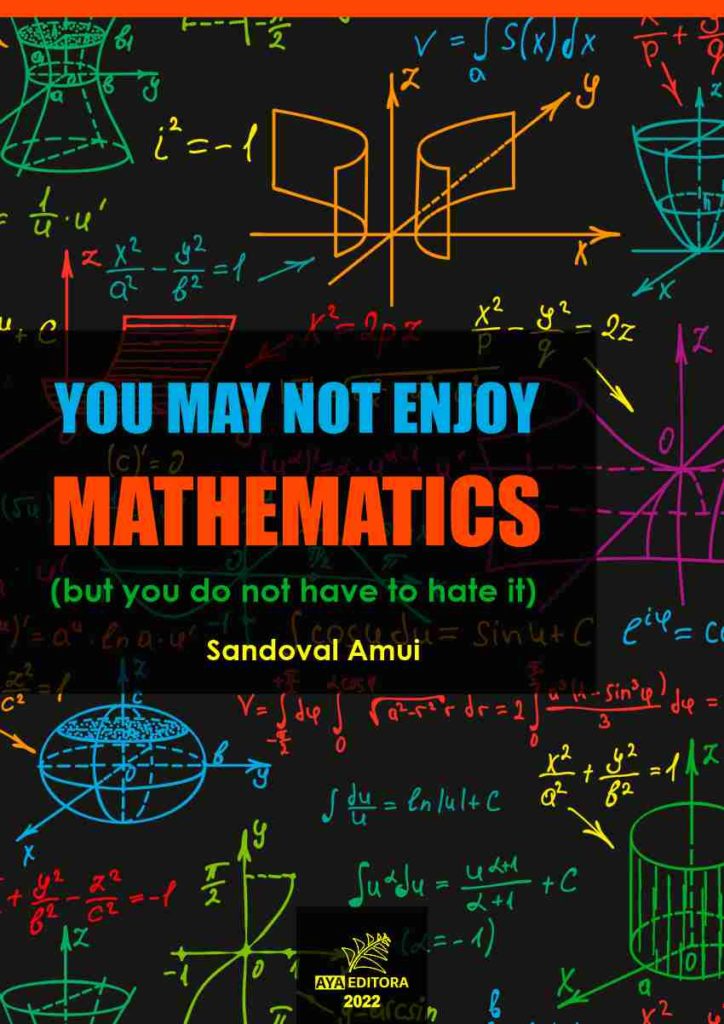
You may not enjoy mathematics: (but you do not have to hate it)
Autor:
Sandoval Amui
ISBN
978-65-5379-015-5
DOI:
10.47573/aya.5379.1.39
N° páginas:
111
Formato:
Livro Digital (PDF)
Publicado em:
11-03-2022
Área do Conhecimento
Licença:
In writing this book, I kept in mind the vast contingent of people, who say they hate math.
In this book, I propose some innovative (although highly polemic) math concepts, which will lead us to a different math structure. I believe the speculative character of this book makes it quite different from others.
I am aware this is a bold initiative, particularly coming from a person, who never had mathematics as his professional field of endeavor. Math is an ancient science, known as the “Queen of Sciences”, and reputed to be the most difficult discipline in any academic program.
Just to prepare the reader’s mind, I say that the new math structure I propose (here named the “New Math Model”) will deliver the same useful results as the math structure in use (here called the “Traditional Math Model”) does.
Next, comes the inevitable question:
Why should anyone bother with the inconvenience and trouble to replace an ancient math structure, which yields useful results, by a new one, which delivers the same useful results?
To that extent, I will present sustainable arguments to convince the reader that this new approach is worth the effort. Initially, I must say that the rationale behind theoretical explanations and the interpretation of results will be significantly different under the New Math Model.
Additionally, any person with a minimal familiarity with math knows that, in addition to the useful results, the Traditional Math Model yields strange results, as imaginary roots of equations, equations with strange roots, indeterminate forms, multiplication and division operations with positive and negative numbers and terms, and other oddities not satisfactorily explained. Current concepts often accept positive values as equivalent to absolute values, what is not always a valid approach.
It is undeniable that most students in math classes do not achieve the same performance and grades they do when attending other disciplines. In addition to poorer learning, it is no secret that most students and people in general dislike the science of math.
I often hear highly skilled people say they hate math.
It is an unquestionable fact that most people in their day-to-day activities only need an understanding of elementary math, a knowledge that does not go much further beyond the four basic arithmetic operations. This fact should be enough to justify the updating of the math programs in undergraduate schools. Complex and abstract matters should be part of advanced math programs.
I dare to say that some unproven conjectures and unsolved math problems, including the so-called “Millennium Problems” (math problems the Clay Mathematics Institute offers significant money prizes to whom will solve any of them) may be improper statements, formulated on invalid premises. In other words, it is not possible to prove a conjecture or solve a problem, if said conjecture or problem does not exist.
Notwithstanding all these unquestionable odd situations, specialists keep adding new theories to the math model in force, building a giant structure over a defective foundation. Any time they find an inconsistent result, they provide strange (and clearly unacceptable) explanations, instead of questioning the fundamentals used.
We have to accept the obvious conclusion: there is something wrong with math!
That conclusion is the main reason why we should open our minds, and consider a new math structure, simpler and more consistent math model, free of poorly explained odd results, less abstract and better aligned with the real world. This is an attempt to improve students’ achievements and people’s appreciation when dealing with math matters.
The introduction of the new math structure fundamentals is the goal I have in mind. It may sound too presumptuous, I admit. However, it is simply a well-meaning attempt to raise and offer a different view about certain math subjects.
If you don’t try, you won’t fail. If you do try, you may fail anyway, but you may succeed.
In the following pages of this book, I will present arguments, which support my own answer to the question made above, as well as the guidelines to follow to achieve that target.
In addition to questioning some math results and their odd explanations, I accepted a different interpretation for some math fundamentals, as the concept of numbers, and introduced a Fundamental Axiom of Mathematics and an Alternative Cartesian System. As a by-product, I made a clear distinction between positive values and absolute values. I also took the opportunity to review other traditional math subjects, such as Pythagoras’ Theorem and Fermat’s Conjecture (Fermat’s Last Theorem after Andrew Wiles), two math subjects, which, in my view, we cannot treat as pure algebraic matters.
I must emphasize that I limited the scope of this book to the analysis of math fundamentals. It is not my intention to extend the application of the innovative concepts of the New Math Model to the realm of pure mathematics, or to the math segments of applicable math, except to a few elementary illustrative examples, with the purpose to test their feasibility. Nevertheless, to the extent I could verify, they worked perfectly.
It is also relevant to emphasize that the introduction of innovative concepts to the science of math will not be sufficient to improve students’ achievements when attending courses on this science. It is also necessary to review and update the didactic approach adopted by academic programs. The present approach, in addition to dealing with questionable abstract subjects, emphasizes the calculation phase when solving math problems. This is a mechanical task that modern machines will perform with incomparable speed and accuracy, leaving in a secondary plane the reasoning about the problems, what they mean, which math concept to use to handle them, and how to interpret the results.
As a tool to serve other areas of the human knowledge, math deals with different matters, which obey their own laws. Under these circumstances, and without breaking its own valid rules, math must conform to the laws ruling the area it serves. For example, the letter “x” in an algebraic expression may mean the unknown value of an equation, a geometric property of a geometric figure or the abscissa of a point that belongs to a curve placed in the Cartesian graph, as well as a physical property in a scientific formula. The same letter in a similar math expression may have different meanings, what requires different treatments.
I suppose teachers do not make this concept clear to their students when teaching math classes. Perhaps, because they themselves do not have that perception. My suggestions will not solve all the inconsistencies we find when using the present math structure, but at least will improve the instrument. The new math structure will be less abstract, more accurate, and will not require odd explanations.
“Logical reasoning” is the foundation and “simplicity” is the target of my propositions. My suggestion of a simpler math structure may or may not work satisfactorily, within reasonable doubt. The math structure in use simply does not (that is a certainty).
In writing this book, I kept in mind the vast contingent of people who say they hate math. If the reader is among those persons who have such unpleasant feeling against math, I am convinced that he or she would not hate the math and the teaching approach I propose in this text (at least, not as much as he or she hates the present math approach).
You may not enjoy math, but you do not have to hate it.
Sandoval Amui
was born on March 03, 1939, in Sacramento, Minas Gerais, Brazil. He is a civil engineer, who holds a M.Sc. degree in petroleum engineering from Louisiana State University, with other graduate courses in offshore engineering from the University of Texas at Austin. He is also an attorney, and retired in 2020, after many years of work with international oil companies and law firms. During his long lasting carrier, he published articles and books on technical and legal subjects. Recently he has devoted his time to other personal enjoyable activities, including writing papers and books on mathematics and geometry. Mr. Amui emphasizes that he has never had mathematics as his professional field of endeavor.
Ler On-line

